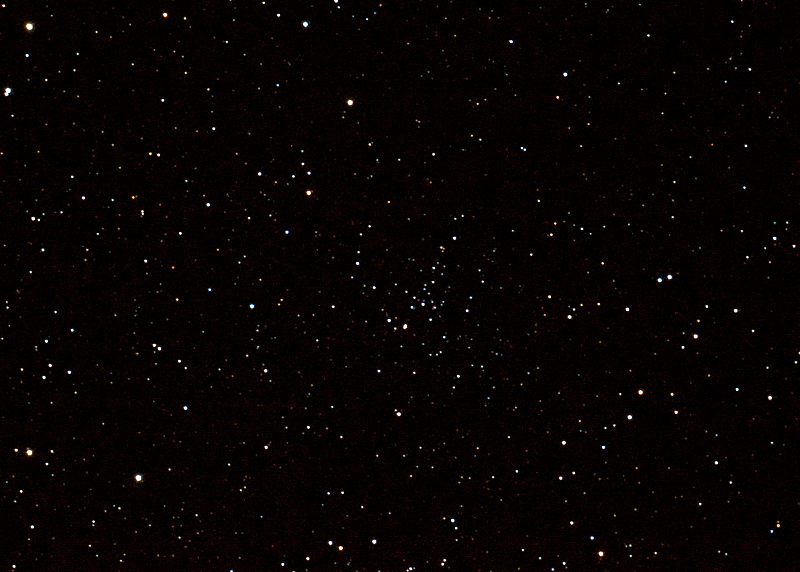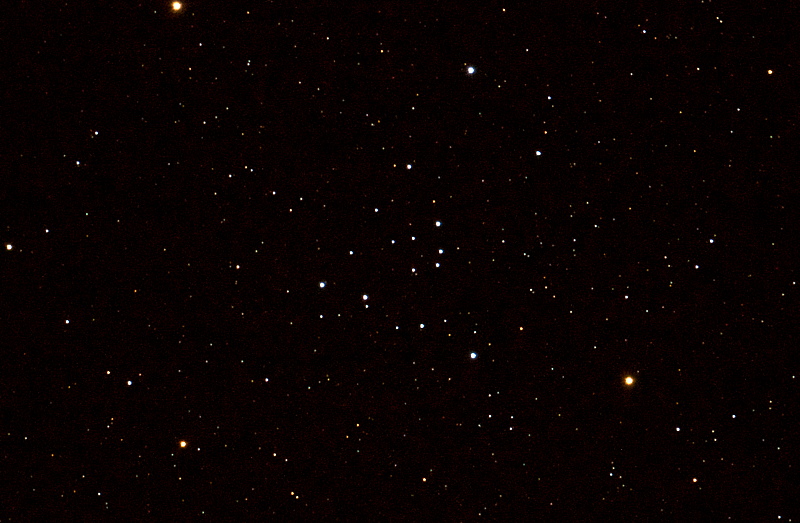DSLR: Moon, ISS, Cassiopeia DSOs, Asteroid 6 Hebe;
iPhone: Moon, DSOs
Posted: 28 October 2014
Unforecasted clouds appeared on Saturday, 25 October, so I wasn't able to do a planned second image of Asteroid 6 Hebe to show motion over 24 hours. The sky finally cleared on Monday, 27 October.
|
Opened: Monday, 27 October 2014, 1808 MST Temperature: 77°F |
Session: 735 Conditions: Clear, but humid |
1816 MST: quick look at the crescent moon, 83X. Then began preparing for a good pass of the International Space Station (ISS). Updated the ISS TLE using the AutoStar. The station had made a "debris avoidance maneuver" earlier in the day which likely made the TLE inaccurate. Checked the observatory clock with WWV. Mounted the D7000 DSLR at prime focus + 2X PowerMate. Checked the finderscope alignment; it was OK. Used the moon to focus:

I was then ready for the ISS pass to begin. When it appeared, the telescope was pointing several degrees in the wrong direction. Once I caught up to the ISS, I began doing a HD video recording, 1/1250sec, ISO 4000. This pass was a close one at 552 miles at its closest. This image shows several views near mid-pass:

Next, I did some handheld iPhone 5s afocal 77X lunar imaging:

Earthshine with the iPhone:

1929 MST: even though the moon had not set yet, it wasn't much of a factor so I decided to checkout the Cassiopeia article on open clusters in the December 2014 issue of Sky & Telescope. Using 83X, I viewed several of objects discussed in the article: NGC7789 (open cluster), NGC103 (open cluster), NGC136 (open cluster), NGC743 (open cluster), and IC1747 (small faint planetary nebula). At 1937 MST, began setting up to image these objects for my Cassiopeia photo album. Did a focus test on the star Shedir (Alp Cas) using the Bahtinov Mask.
The following were taken using 30 seconds, ISO 2500, unguided, at prime focus of the 8" LX200-ACF.
NGC7789 (open cluster)

NGC103 (open cluster)

NGC136 (open cluster)

NGC743 (open cluster)

IC1747 (planetary nebula; cropped)

2003 MST: ended DSLR DSO imaging. Began doing some iPhone 5s DSO imaging using the iOS app "NightCap Pro". The app was set for Night Mode, Long Exposure, and Light Boost. The images were taken using a 26mm eyepiece + focal reducer using a modified MX-1 Afocal Adapter. First did the Double Cluster at 1 minute:

Next, tried M31 (Andromeda Galaxy). iOS kept changing the focus even though the focus lock was on. The focus actually drifted during the 1 minute exposure, but NightCap Pro was able to capture the core of the galaxy:

Last, I tried M45 (the Pleiades). Focus continued to drift during the exposure but many stars were imaged:

2110 MST: ended iPhone DSO imaging and viewed M45. Nice view using the focal reducer.
Took a short break 2139-2155 MST to replenish my hot chocolate.
2203 MST: slewed to Asteroid 6 Hebe, but it was too low and in a tree. Powered on the GC Wi-Fi Adapter and used SkySafari Pro on the iPhone to GOTO Asteroid 6 Hebe. I prefer using SkySafari for GOTOs to faint solar system objects as the database in the telescope is several years out-of-date. Once the asteroid was out of the tree I tried to ID it using its position shown on the iPhone. I thought I saw it but wasn't certain.
2235 MST: began setting up for D7000 DSLR prime focus imaging. Did a focus test on Aldebaran. Also SYNCed the AutoStar on Aldebaran. Did three 30 second, ISO 2500, unguided exposures of Asteroid 6 Hebe at 2300, 2330, and 0000 MST. Asteroid movement was very evident after the second exposure. The following image shows Asteroid 6 Hebe at the center (cropped from the full-frame image):

Mouseover or tap on the image to see animation
After imaging was completed I viewed Asteroid 6 Hebe at 83X. Its movement during the hour of imaging was very obvious.
Before closing the observatory I took a quick look at M42 (Great Orion Nebula), 83X. I also did some sky quality readings even though the humidity was high. The Unihedron SQM-L got 21.08 and DSM 2.0 got 21.21.
|
Closed: Tuesday, 28 October 2014, 0013 MST Temperature: 61°F |
|
Comments are welcome using Email. If you are on Twitter you can use the button below to tweet this report to your followers. Thanks.
Cassiopeia Observatory Home Page
Copyright ©2014 Michael L. Weasner / mweasner@me.com
URL = http://www.weasner.com/co/Reports/2014/10/28/index.html
